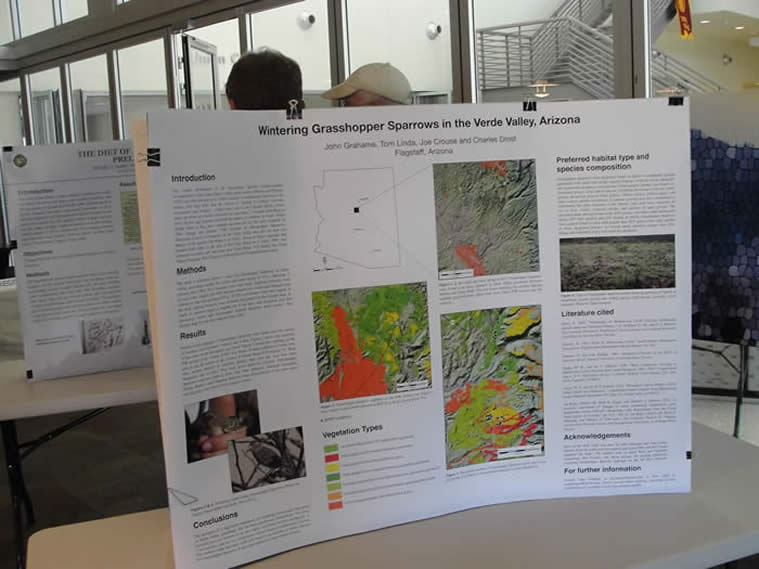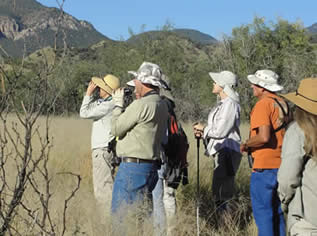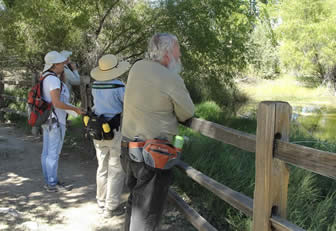Arizona Field Ornithologists
Seventh Annual State Meeting Summary
For Field Mini-Expedition Highlights click here
Text by Erika Wilson
Photos by Doug Jenness and John Yerger
 The 7th annual meeting of the AZFO, themed as “The Lesser Known Southeastern Arizona,” was held at Cochise College in Sierra Vista on 5 October 2013. Sixty-two people attended—one quarter each from the Phoenix Metro area, the Tucson Metro area, and Cochise County, with the remaining quarter coming from the western and northern parts of the state. Troy Corman, president, opened the meeting, welcoming everyone. He noted that the federal government shutdown had several negative effects on the meeting: the cancellation of Dr. Janet Ruth’s keynote address because of her status as a furloughed federal employee and the loss of a San Pedro House Book Store sales table, because the store is located on BLM land, and therefore closed. However, concern that the mini-field expeditions would be canceled was allayed by the USFS decision to allow access to Coronado National Forest lands, although facilities within the forest were closed.
The 7th annual meeting of the AZFO, themed as “The Lesser Known Southeastern Arizona,” was held at Cochise College in Sierra Vista on 5 October 2013. Sixty-two people attended—one quarter each from the Phoenix Metro area, the Tucson Metro area, and Cochise County, with the remaining quarter coming from the western and northern parts of the state. Troy Corman, president, opened the meeting, welcoming everyone. He noted that the federal government shutdown had several negative effects on the meeting: the cancellation of Dr. Janet Ruth’s keynote address because of her status as a furloughed federal employee and the loss of a San Pedro House Book Store sales table, because the store is located on BLM land, and therefore closed. However, concern that the mini-field expeditions would be canceled was allayed by the USFS decision to allow access to Coronado National Forest lands, although facilities within the forest were closed.
Carol Beardmore, moderator, opened the paper session by introducing Pierre Deviche, who announced recipients of two Gale Monson Research Grants for 2013-14: Zach Smith and David Vander Pluym. Each will receive $2,000. Zach will conduct spring raptor surveys in Prescott National Forest, and David will study spring migration on Lake Havasu, recording nocturnal flight calls, and conducting visual surveys of water birds. David briefly explained that most survey work on the lower Colorado River has been focused on riparian breeding birds, but that sightings the past two years have revealed major use of the river by a surprising number of ducks, loons, grebes, cormorants, boobies, gulls, and even some storm-assisted sea birds. Janet Witzeman reminded everyone that the book Counting Birds with Gale Monson is still available, and that the proceeds support the Gale Monson Research Grants. AZFO has sold 70+ copies, and is making an effort to promote the book to libraries as part of their local history sections. Nine of the books were sold at the meeting.
During the paper session Michael Lester (2012-13 Gale Monson Research Grant recipient), spoke about the accumulation of heavy metals in Song Sparrows along the upper Santa Cruz River. Jennie MacFarland of Arizona Audubon discussed the Important Birding Area (IBA) program in Arizona, noting the importance of birders' participation in the surveys that lead to an area being designated an IBA. Both talks generated questions from the audience.
These presentations were followed by Peter Collins, who has been monitoring the spring migration of Common Black-Hawk up the Santa Cruz River, between Tucson and Nogales. In 2013 a total of 231 Common Black-Hawks were counted at Ron Morris County Park, Tubac, making this route a major corridor for northbound hawks. Next, Amanda Moors gave a fascinating look at the effects of wildfires on "Mexican" Spotted Owls, especially in relation to subsequent use of territories and nesting success. Pairs have strong site fidelity and produce more young/nest in years immediately after a major fire.
A short business meeting followed: Doug Jenness, treasurer, reported on the 2013 budget, noting a drop in membership affecting income, and an increase in expenses, particularly the purchase of a liability insurance policy. He also reported on the financial status of the Gale Monson Research Grants. Troy Corman explained the reasons behind proposed changes in the by-laws lengthening officer and board member terms from one to two years and staggering the terms. He also reported that he wasn't planning to put his name forward as a candidate for president. The amendment was adopted unanimously. Carol Beardmore presented a list of nominees for the three officer positions and one board position that were open. There being no nominations from the floor, the nominees were voted in unanimously for two-year terms. Elected were: Kurt Radamaker, president; Muriel Neddermeyer, membership secretary; Erika Wilson, recording secretary, and one board member at large, Eric Hough. Not up for election this year were the positions for vice-president, treasurer, and two at-large Board positions, currently held by Marceline VandeWater, Doug Jenness, Lauren Harter, and John Yerger, respectively.

Lauren Harter then described the new AZFO Youth Scholarship program, which is aimed at assisting high school and undergraduate college students to attend AZFO annual meetings.
Two much anticipated events of AZFO meetings are the photo identification quiz and audio quiz. The former was displayed in the meeting room throughout the day, while the audio quiz was conducted by Pierre Deviche before the lunch break. Ten bird vocalizations were played, ranging from easy to very difficult. Answers to both quizzes were discussed at the end of the meeting. Brief reports on the three Friday mini-field expeditions included an unusual sighting of a male Elegant Trogon in French Joe Canyon in the Whetstone Mountains.
The afternoon session began with Lauren Harter’s report on the Arizona Bird Committee’s activities during the past year. She noted the split of Sage Sparrow into two species: Bell's Sparrow and Sagebrush Sparrow. The most expected one in Arizona is the Sagebrush Sparrow, but Bell’s Sparrow may be possible in the western part of the state. ABC is also working on a project to digitize all past ABC records. Edwin Juarez then reported on the AZFO website, noting that the photo documentation pages were the most heavily used. The new AZFO Facebook page has 90+ followers so far and continues to draw new viewers. It has attracted links from aba.org and other avian organizations.
The next three speakers were Richard Webster on the underbirded Rio Yaqui in the San Bernardino Valley; Eric Hough on the effects of wildfires in different life zones on the avifauna, particularly in the Sky Islands; and Charles Melton on breeding White-eared Hummingbirds in Miller Canyon, Huachuca Mountains. All the talks were well-illustrated, listened to with interest, and elicited good questions from the audience. A mid-afternoon break followed, with members encouraged to look at the four poster papers on: Golden Eagle diets, the expansion of Tropical Kingbird distribution in Arizona, Wintering Grasshopper Sparrows in the Verde Valley, and a summary of Sonoran Desert breeding bird surveys.

The afternoon session was completed with reports by Pierre Deviche about Arizona Birds Online and John Yerger about past and future AZFO expeditions and workshops. The audio quiz was won by Yerger with eight correct answers out of 10; and the photo contest resulted in a tie between Michael Lester and Yerger, both of whom got all 10 answers correct in the main quiz, as well as the extra photo meant to break the tie. The raffle drawing was well-supported, with two books donated by Tucson Audubon Society, and two books by AZFO. As usual the used book table was popular as shown by $476 in sales. Troy Corman closed the meeting, thanking all those who made the local arrangements and organized the mini-field trips. He announced that the next state meeting will be in central Arizona in October 2014.
 After an off-campus social hour, the evening banquet was held in the meeting room. John Yerger opened the evening program, introducing Doug Jenness who talked about the early founding meetings of the AZFO, including the pivotal role played by Troy Corman. To a round of applause, a handsome plaque was given to Troy, inscribed as follows:
After an off-campus social hour, the evening banquet was held in the meeting room. John Yerger opened the evening program, introducing Doug Jenness who talked about the early founding meetings of the AZFO, including the pivotal role played by Troy Corman. To a round of applause, a handsome plaque was given to Troy, inscribed as follows:
TROY CORMAN
Presented in recognition of your vision and dedication to making the Arizona Field Ornithologists what it is today, a key organization for increasing our knowledge of Arizona's birdlife.
The keynote address was presented by Richard Webster on hummingbirds. The opening section focused on identification of Arizona’s species, followed by a fascinating discussion of Anna’s Hummingbird ecology, and ending with a selection of beautiful photographs of hummingbirds from throughout the Western Hemisphere.
Six Mini-Field Expeditions
At the 2013 Annual AZFO State Meeting
Text by John Yerger
 Six different “mini” Field Expeditions were organized as part of the AZFO state meeting. Three of these took place the afternoon before the meeting, and three occurred the morning after. Brief summaries follow:
Six different “mini” Field Expeditions were organized as part of the AZFO state meeting. Three of these took place the afternoon before the meeting, and three occurred the morning after. Brief summaries follow:
4 OCTOBER MINI-EXPEDITIONS:
• In Hunter Canyon (Huachuca Mts), Michael Lester led a group of 14 birders that enjoyed nearly 100 White-throated Swifts acrobatically foraging overhead. All three jay species (Mexican, Western Scrub, and Steller’s) demonstrated the diversity of the area, even among blackened oak trunks from the 2011 Monument Fire; lingering Hepatic Tanager and Scott’s Oriole were also highlights.
• In French Joe Canyon (Whetstone Mts.), Robert Weissler led a group of 10 into an area where Rufous-capped Warbler has been found in the past. While this rarity was not detected on the trip, an adult male Elegant Trogon was an excellent find, as the species is not typically detected in this mountain range and the timing seems to indicate a post-breeding wanderer. It’s not often one can see trogons and Red-naped Sapsuckers together! Black-throated Gray and Townsend’s warblers were among migrants detected.
• A small group birded the Appleton-Whittell Research Ranch, which is normally closed to the public, led by Homer Hansen. They were able to enjoy many of the species typical of the San Rafael grasslands.
 6 OCTOBER MINI-EXPEDITIONS:
6 OCTOBER MINI-EXPEDITIONS:
• Robert Weissler took a mini-Expedition with 14 folks into Scotia and Sunnyside Canyons, on the west side of the Huachuca Mountains. Although a female bear with two cubs was probably the highlight for everyone, the avian stars were Olive Warblers, Hepatic Tanager, and Arizona Woodpeckers, along with a lingering young Scott’s Oriole.
• A venture into Brown Canyon (east side, Huachuca Mts.) with Erika Wilson and 11 people yielded 35 species. Though the morning seemed relatively quiet, a late migrant Olive-sided Flycatcher was enjoyed by all.
• Finally, a slow stroll on private land along the San Pedro River south of Charleston Bridge resulted in several big surprises, including a male Painted Bunting and a female Green Kingfisher! A lingering Gray Hawk rounded out the morning.